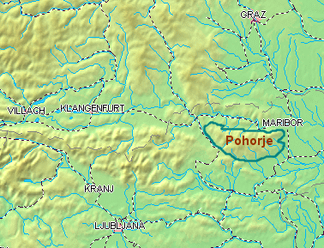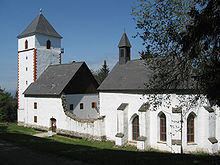Bacher Mountains
| Pohorje / Bacher Mountains | |
|---|---|
|
Location of the Pohorje |
|
|
The Pohorje near Marburg |
|
| Highest peak | Črni Vrh ( 1543 m. I. Y. ) |
| location | Slovenia |
| part of | Karawanken and Bacher Mountains |
| Coordinates | 46 ° 30 ' N , 15 ° 27' E |
The Pohorje ( German Bachergebirge , also Bacherngebirge or Bachern for short ) is a densely forested low mountain range in northern Slovenia . The mountainous region is roughly bounded by the city triangle of Maribor (east), Dravograd (west) and Slovenske Konjice (south). Its east-west extension is about 50 kilometers, that from north to south 30 kilometers. Pohorje is only sparsely populated, but it plays a major role both in Slovenian winter tourism (women's World Cup races for the Golden Fox ) and as a hiking and recreation area in summer and autumn.
location
The Pohorje is a wide mountain ridge that stretches for about 1000 square kilometers south of the Drava . It is a densely forested ridge without any prominent peaks. The highest elevations are the Črni Vrh / Schwarzkogel ( 1543 m. I. Y. Year ), the Velika Kopa , which is only one meter lower, and the somewhat more southerly lying Rogla ( 1517 m. Y. Y. ). This area is bounded in the west by the Mislinja (Missling) and in the south by the Dravinja (Drann), in the east the ridge at Maribor slopes down to Ptujsko polje (Pettauer Feld).
geology
The Pohorje belongs to the Central Alps ; geologically there is a connection to the north-western Lavanttal Alps (including Koralpe and Saualpe ). In its central part, the Pohorje is made up of silicate stones , mainly tonalite and dacite . In the peripheral areas, metamorphic (crystalline) gneisses predominate . In the south-eastern part, some areas are overlaid by Trias limestone . The area is also known among geologists for a gabbroide rock, cizlakite , a solid, green-gray material that was used in ancient times and was mainly used for tombstones in modern times.
landscape
The relatively high annual rainfall and the impermeable subsoil cause a large number of springs, small brooks and rivers that arise in the Pohorje and drain either north to the Drava or south to the Save . Overall, the Pohorje has the densest network of flowing waters in Slovenia. In the partially steeply sloping edge areas there are some quite impressive waterfalls, such as the Great Šumik, in the vicinity of which there is also the last undisturbed primary forest in the area.
In the central part of the Pohorje forms a plateau that has been partially cleared and has been used as pasture for cattle since ancient times. These pastures, called Planje, are home to some very rare plant species. Also in the central part, at around 1400 meters above sea level, there is a largely runoff-free moorland in which many lakes and small ponds are embedded. Most of the Pohorje, however, is covered by contiguous, large and dense forests. Coniferous forests , spruces and pines in the lower areas, firs in the higher areas, dominate, but many other tree species, especially sweet chestnuts, are scattered in these forests. A total of eleven areas are considered forest reserves, in which only very limited and near-natural use is permitted.
Flora and fauna
In addition to some giant trees (for example the Marolt fir (Maroltova jelka) or the Dolar chestnut), which are considered to be the largest representatives of their species worldwide and are admired above all by tourists, the area is primarily known to botanists as a connecting region between the flora of the Central Central Europe and that of South Central Europe and the Dinaricium known. The rust-leaved alpine rose ( Rhododendron ferrugineum ) is quite common as a typical silicate indicator , as is arnica and various types of gentian, including the relatively rare Pannonian gentian ( Gentiana pannonica ). In the moor areas you will find the plant communities of the extremely nutrient-poor rain bogs , including the round-leaved sundew ( Drosera rotundifolia ). The forests are extremely rich in mushrooms. The Pohorje is a good find area for the Marchellerling ( Hygrophorus marzuolus ), in the south-western and southern deciduous forest regions the king's boletus ( Butyriboletus regius ) occurs. Occasionally, Emperorlings ( Amanita caesarea ) are also found.
The animal world is also very rich in species, even if native species such as lynx ( Lynx lynx ), wolf ( Canis lupus ) and brown bear ( Ursus arctos ) have originally disappeared. Brown bears move from the Karawanken to this area only occasionally , but have not yet established a stable population. Red deer ( Cervus elaphus ), roe deer ( Capreolus capreolus ) and chamois ( Rupicapra rupicapra ) are the most common large animals in the area today. They are looked after intensively when they are hunting and thus reach overpopulations - much to the detriment of the ecological structure. The wild cat ( Felis silvestris ) is rare, and as everywhere threatened by interbreeding with feral domestic cats , and also otters ( Lutra lutra ) could only survive in some areas of the Pohorje.
The large forest area, in some cases very rich in dead wood , is home to many species of birds. All European woodpecker species occur as breeding birds in the area, also capercaillie ( Tetrao urogallus ) and black grouse ( Lyrurus tetrix ) are still relatively common. The dipper ( Cinclus cinclus ) is native to the clear, fast-flowing streams . Occasionally the Ural Owl ( Strix uralensis ) also breeds in the Pohorje forests.
The insect fauna is particularly rich in species. Over 700 different species of butterflies can be found in Pohorje, including the very rare blue moorland ( Plebius optilete ) and the great peacock butterfly ( Saturnia pyri ). It was not until 1980 that a stonefly species, Leuctra istenicae , was discovered as an endemic species in the area of Lake Ribniško.
Settlement
The Pohorje is only very sparsely populated. Seasonal alpine pasture and pasture farming was mainly carried out on the cleared areas, the villages are located in the foothills of the mountains and in the valley basins. The only larger settlement in central Pohorje is Lovrenc na Pohorju . In the south-facing, sun-exposed locations, there are a few small properties whose residents could operate subsistence farming there. Today many of these hamlets are deserted. In addition to this self-sufficient agriculture, logging and charcoal burning were the most important sources of income for the population living here. The charcoal primarily supplied regionally important glassworks with energy. Characteristic for the area are some lonely churches, of which the Heinrichskirche Sveti Areh from the late 17th century is the best known.
literature
- Paul Schlosser: The legends of the Poštela , A look into the Bachern kingdom, Marburg 1912.
- Paul Schlosser: Bachern sagas , folk traditions from the old Lower Styria, Vienna 1956.




